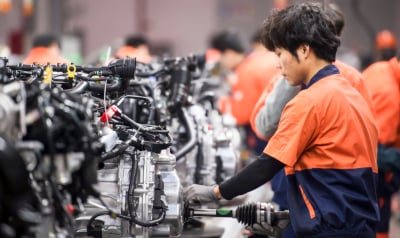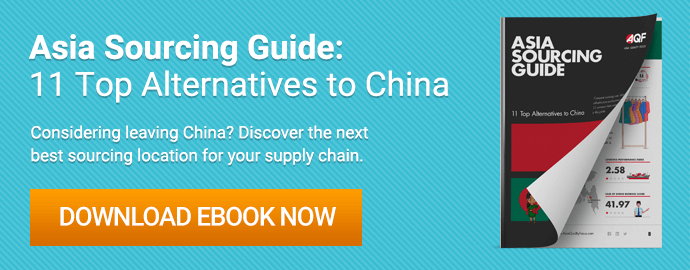Best in Manufacturing – February 09, 2020
Each Sunday, we publish a list of top articles and other content related to manufacturing in areas like quality control, product development, supply chain management, sourcing, auditing and law.
1. Cambodia: a new option for U.S. furniture industry
 The furniture industry is a market of huge potential as people are chasing higher living quality with better furniture. According to an estimation, the global furniture industry will reach $472 billion by 2024. And among this market of big potential, the U.S. is the largest single market furniture importer.
The furniture industry is a market of huge potential as people are chasing higher living quality with better furniture. According to an estimation, the global furniture industry will reach $472 billion by 2024. And among this market of big potential, the U.S. is the largest single market furniture importer.
In 2018, the U.S. imported about $72 billion of furniture and China has long been its main furniture supplier. But the 25 percent tariff caused by the trade war has deeply affected the U.S.’s furniture supply chain. Some furniture companies are relocating to dodge tariffs.
Although President Trump urged the manufacturing industry to come back to the U.S., the results are not as expected. Clarence Smith, CEO of Haverty Furniture, said wood furniture “is not coming back” to the U.S. Even though their Asian suppliers still source much of the timber they use from the U.S.
Instead, they moved from China to Vietnam. But now, they are looking at Cambodia and are planning to leave Vietnam.
Why are they leaving Vietnam?
Manufacturers always say Vietnam might become their next China but this country seems to be over-capacity now. Some are planning or already have left Vietnam to build new manufacturing lines (related: Manufacturers Looked to Vietnam as a Tariff Shelter. So Why Are They Leaving Now?).
Here are some main points that are driving manufacturers to relocate from Vietnam:
- Wage rise: Vietnam’s monthly minimum wagesin 2019 varies by region from $125 to $180. There was a 5.3 percent increase in 2019 and will increase stably in the future.
- Skilled labor shortage: Only 12 percent of Vietnam’s 57.5 million-strong workforce are highly skilled (see #3). The lack of skilled labor can’t support the companies with high-tech manufacturing needs.
- Potential tariff threat: In the first 10 months of 2019, Vietnam’s trade surplus with the U.S. increased 39.3 percent compared to the same period in 2018. President Trump has threatened to make Vietnam as next trade war target.
Also, manufacturers in Vietnam have to rely on foreign inputs for production across a variety of industries, including garments, electronics and pharmaceutical. This squeezes the profit and has pushed some manufacturers to leave.
How is manufacturing in Cambodia?
No matter what industry are you in, it’s always good to have a backup plan for manufacturing relocation. Let’s explore the good and bad about manufacturing in Cambodia (related: Is Cambodia Poised to Become a Major Manufacturing Hub?).
Cambodia is a Southeast Asian country with one of the lowest labor costs in Asia. This country is especially suitable for garment manufacturing as this industry accounts for 63 percent of Cambodia’s total exports.
Plus, it’s a good idea to manufacturer footwear and headwear in Cambodia. Footwear and headwear are collectively Cambodia’s second-largest export.
However, Cambodia is far from perfect. Cambodia has a limited labor size as it’s one of the smallest labor forces in Asia. You might come across a labor shortage in Cambodia if your manufacturing need is labor-intensive.
Cambodia’s poor infrastructure also lags Cambodia’s development. The World Bank’s 2018 Logistics Performance Index ranks Cambodia 98th globally while China is 26th and Vietnam is 39th. You must find ways to improve your shipping efficiency when manufacturing in Cambodia.
Follow the link below to learn more about why the U.S. furniture makers are planning to move to Cambodia from Vietnam.
U.S. Furniture Industry Eyes Cambodia as Vietnam’s Wages Rise – Michael Sasso, Bloomberg
2. The EU plans to have a closer bond with Bangladesh
The European Union is the largest economy and the largest trading bloc in the world. The average applied tariff for goods imported into the EU is very low and more than 70 percent of imports enter the EU at zero or reduced tariffs. For developing countries, the EU is a strong and friendly partner.
largest trading bloc in the world. The average applied tariff for goods imported into the EU is very low and more than 70 percent of imports enter the EU at zero or reduced tariffs. For developing countries, the EU is a strong and friendly partner.
Recently, the EU is looking closely as Bangladesh as the largest exporter among the least-developed countries. Rensje Teerink, the ambassador of the EU to Bangladesh, said the Bangladesh needs more trade facilities to further develop manufacturing industry and it’s hard to do it without the EU.
Bangladesh exports billions worth of garment products to the EU annually. And the EU is a “major instrument” that has helped Bangladesh with trade facilities. Currently, around 70 percent of all Bangladeshi goods are relying on the trade facilities that the EU provided. Rensje Teerink said:
I think this has been enormously helpful. There’s no other organization in the world that grants this kind of privilege to Bangladesh.
Bangladesh should stay compliant with the EU’s standard
Although the EU is placing hope on Bangladesh, this country still has to work hard and stay compliant with the EU. The ambassador said:
Dhaka has made commendable progress but it must do more to make sure that practices at its factories are in compliance with the ILO standards if Bangladesh wants to continue enjoying trade facilities being provided by the EU.
One of the most important point that Bangladesh should focus on is the domestic working condition.
The Rana Plaza Accident in 2013 shocked the world and drove many manufacturers out from Bangladesh. The accident pushed the European customers to establish a monitoring body called the Accord on Fire and Building Safety (the Accord) to improve factory safety in Bangladesh. The Accord made big improvements but will expire at around mid-year 2020.
To keep monitoring and improving the working conditions and stay compliant, the Bangladesh government and brands members agreed to transfer the Accord’s responsibility to a new body: the Readymade Sustainability Council (RSC).
In the future, the RSC will inherit the Accord’s staff and infrastructure once the Accord leaves Bangladesh. The new monitoring body will assist Bangladesh to build a closer relationship with the EU.
The EU’s trade relationship with Cambodia is still unclear
While Bangladesh seems to have a prospect future with the EU, Cambodia’s trade relationship with the EU is shrouded in mist.
Cambodia’s trade with the EU is benefitted by a trade scheme called “Everything But Arms” (EBA). Under the EBA, 99 percent of the goods that Cambodia export to the bloc is under zero tariffs. But the EU questioned Cambodia on human and labor rights and might revoke its EBA privileges (see #3).
If the EBA leaves, Cambodia’s manufacturing sector will suffer a huge hit as tariffs on Cambodia-made goods will significantly increase. Take Cambodia’s pillar garment and footwear industry as an example. If the EBA leaves, the garments export to the EU will bear a 12 percent tariff. There will also be a 16 percent tariff on footwear and 10 percent tariff on bicycles.
To keep its EBA status, the Cambodian government has made efforts like wage rise to show its importance to human rights. Under Cambodia’s move, the EU weighed softer stance toward Cambodia over human rights but there’s no clear conclusion yet.
Follow the link below to learn more the EU’s attitude towards Bangladesh.
European Union looking closely at Bangladesh: Teerink – Staff, New Age
3. China’s manufacturing is still clouded despite trade deal
 Nobody can doubt that China is the world’s factory. This country has spoiled the manufacturers with a huge labor force, low land rent and highly-developing manufacturing skills. However, the U.S.-China trade war has changed the game and China is no longer the perfect place for manufacturing.
Nobody can doubt that China is the world’s factory. This country has spoiled the manufacturers with a huge labor force, low land rent and highly-developing manufacturing skills. However, the U.S.-China trade war has changed the game and China is no longer the perfect place for manufacturing.
More tariffs are placed on made-in-China products and companies are leaving to save their business. Although the U.S. and China have signed the “Phase one” trade deal, China’s manufacturing is still clouded. Larry Sloven, a veteran manufacturer, said:
Even if the tariffs went away tomorrow, most people are not coming back,” he said. “But I do not believe that most retailers in America understand this process of what a supplier must go through. Nobody will pay the price.
The rising labor cost, complex regulatory environment, and potential tariff threat even under the trade deal, means that the manufacturing exodus won’t end within the decade.
Sitting on the sidelines is “more of a new normal”
John Evans, managing director at Tractus Asia, advise companies to relocate from China even with the “Phase one” deal:
There were still a number of companies sitting on the sidelines, even into the last quarter of last year, thinking there'll be a grand resolution. But in reality, it’s more of a new normal.
Big companies are starting to develop their departure plan. An anonymous source at a company supplying accessories to Apple said that the giant once told them to have a plan to leave China if they want to keep their supplier position.
Moreover, Estonian manufacturer Gerardo’s Toys is scheduling its relocating plan. Gerardo’s Toys currently manufacturers its rocking horses in China. Allar Peetma, the CEO of Gerardo’s Toys, said the company won’t be comforted by the truce and will plan to manufacturer in the EU.
The “Phase one” trade deal is unlikely to stop the relocation wave. Dan Harris, founder of Harris Bricken, wrote in his blog:
For every foreign company that left China in 2019, there were two to three more seriously contemplating doing so and we expect more companies to leave China in 2020 than in 2019.
Keep Asia sourcing alternatives in your plan
Southeast Asian countries seem to have a huge potential in accommodating manufacturing industry. But according to Larry Sloven, Thailand manufacturing will be overcrowded in a few years:
This is the right stepping stone, just the start. I believe that Vietnam is already full, it's like having a ticket at a bakery, you have to wait in line. Right now, there's no line in Thailand, but it will get full.
The global manufacturing network makes any country vulnerable to tariff attacks. If you import from Asia, you’d better look for Asia sourcing alternatives and diversify your supply chain. You might be already familiar with names like Bangladesh, Cambodia, India and Indonesia. Here are some pros of other players in Asia manufacturing field:
- Malaysia: Exporters in Malaysia benefit from no value-added tax (VAT) on exports and access to two of the busiest ports in Southeast Asia.
- Pakistan: Pakistan is also acting strong in garment and textile industry and Pakistan’s infrastructure is also rapidly improving.
- The Philippines: The biggest pro is that The Philippines has a strong historical political and economic relationship with the U.S. means This country is unlikely to become next trade war target.
Follow the link below to learn more about Chinese manufacturing’s future.
China’s manufacturing exodus set to continue in 2020, despite prospect of trade war deal – Finbarr Bermingham, South China Morning Post
We’re constantly scanning the web for top manufacturing stories and news. If you’d like to submit an article for consideration for our weekly Best in Manufacturing, send us a message and let us know







